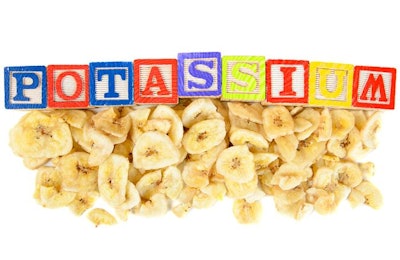
Potassium is an essential nutrient. This means that all animals must receive enough quantities of it through their daily ration. However, it is not a critical nutrient in that under practical conditions, common feed ingredients provide more than enough to cover all animal needs. This is why potassium is grouped among the essential nutrients but rarely receives much attention from nutritionists and feed formulators.
At least this was the theory until recently. Today, potassium is considered an important nutrient that requires monitoring, at least in sensitive diets.
Potassium plays crucial role in metabolism
Although potassium is rarely considered in depth, except as part of the macro-mineral group in graduate courses, it does play a very central role in the everyday life functions of all animals.
- First, it is required for the proper functioning of the nerves and muscles. In experimentally-induced potassium deficiency, animals first lose their appetite and consequently their productivity, followed by muscle weakness and even paralysis. Of course, such levels of deficiency are rather difficult to achieve, but these experiments demonstrate the importance of potassium.
- Second, potassium is involved in the electrolyte balance at cellular level affecting respiration. Potassium deficiency leads to intracellular electrolyte imbalance that is the basis for many metabolic disorders. This is a practical problem during heat stress, where normally the dietary electrolyte balance is increased.
The exact mechanisms of how potassium interacts with other minerals to control these functions are prohibitively complex to be of any practical value. Nevertheless, they do merit study by professionals.
Potassium in common feedstuffs is variable
An indication of potassium concentration in many feed ingredients used in diets for monogastric animals is given in the table "Sodium, potassium, chlorine, dietary electrolyte balance in common feedstuffs." Exact values differ based on source, but variability among concentrated feedstuffs remains low, and the data presented are relatively informative.

Variability among concentrated feedstuffs remains low.
In general, most energy sources, such as cereals and their by-products, are rather low in potassium, containing no more than 0.2 percent. This is usually not a problem when these cereals are supplemented with protein sources, which contain relatively higher levels of potassium. Such protein sources include soybean meal and most other oily seeds and, of course, animal products. However, when the majority of protein in a formula comes from cereal by-products, then potassium levels become critically low. This is, for example, the case with brewer’s grains that have become very trendy in the last decade.
In general, the levels of potassium provided by wheat/corn and soybean meal diets are considered sufficient.
One ingredient that contains ample quantities of potassium is molasses. As most tubers and roots are rich in potassium, this mineral is concentrated in the molasses fraction during sugar extraction from beets. In fact, the high potassium level in molasses has often been blamed for causing diarrheas, but this has never been proven. Controlled trials feeding high levels of molasses or equivalent levels of potassium failed to elicit any diarrheas. All these are better considered as potassium levels inside the dietary electrolyte balance and not as an individual nutrient.
Animal requirements are not well-established for potassium
The relative abundance of potassium in most common feedstuffs creates a difficulty in designing deficient diets to study requirements. Coupled with the lack of interest in potassium supplements, one can understand why most requirement studies are outdated. In general, the levels of potassium provided by wheat/corn and soybean meal diets are considered sufficient. For most diets, these levels are about 1 percent or 10 grams/kilogram finished feed.
Apparently, slight deviations from this very generic figure are not considered problematic. Nevertheless, many nutrition professionals monitor potassium levels when less common ingredients enter the formula, especially when they are used at high levels. In these cases, a potassium source (for example, potassium chloride) can be used to bring up dietary potassium levels.
We are in desperate need of modern data on animal potassium requirements.
It suffices to say that we are in desperate need of modern data on animal potassium requirements. As new by-products and alternative ingredients enter feed formulations for monogastric animals, it is imperative to work with established figures and not with the classic corn-soy potassium average.
Potassium during thermal stress and tail biting
Monogastric animals during thermal stress are characterized by an electrolyte imbalance that is the result of their efforts to combat with heat. Obviously, panting or over-ventilation is one of these mechanisms, and, as expected, it involves potassium (K) along with sodium (Na) and chloride (Cl). These three minerals are the major participants in the equation below, commonly used to measure dietary electrolyte balance (dEB).
- dEB (meq/kg) = Na(g/kg)´1000/23 + K(g/kg)´1000/39 – Cl(g/kg)´1000/35.5
In general, during heat stress, a higher dEB is required. The most commonly quoted figure is that of 250 meq/kg, which can be achieved by adding Na or K sources, and/or reducing Cl sources. In most cases, it is advised to use enough salt (NaCl) to meet the Cl requirement and then add sodium bicarbonate or potassium chloride up to the required level. This is particularly important in layer hens that must not receive an excess of Cl to maintain eggshell quality.
Without knowing exactly why, an elevated dEB has been shown to alleviate the problem of tail biting in young pigs. The same can be said for the addition of plain salt, which brings an almost neutral addition to dEB.
Of course, some experts believe the observations regarding dEB have to do merely with the increased intake of water due to overconsumption of minerals, then it is of little importance which mineral we add. Perhaps the truth remains to be discovered somewhere inbetween, as is so often the case.

















